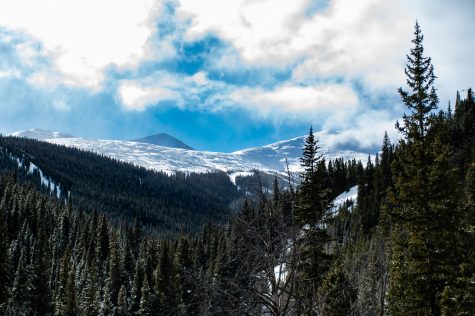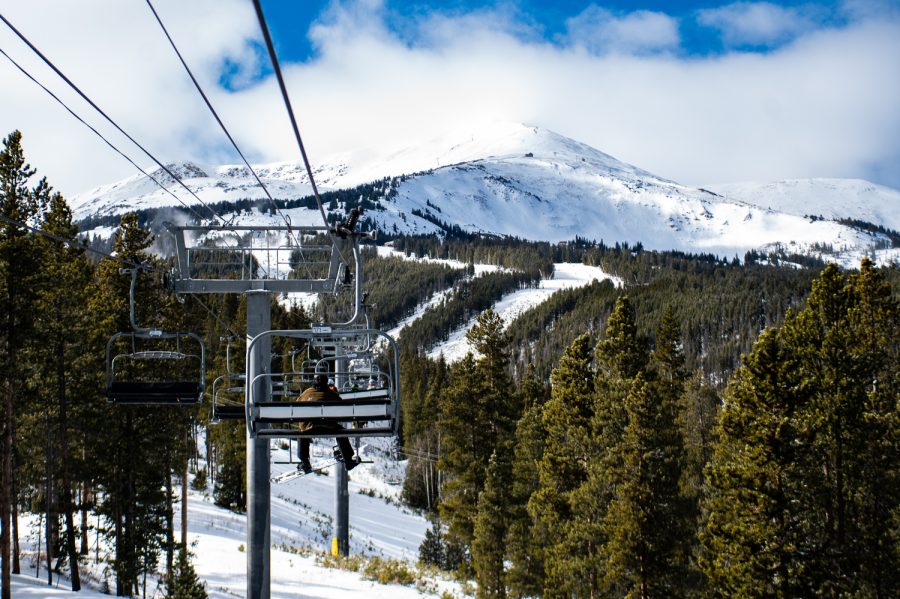Avalanche education: How to stay safe in the backcountry
Collegian | Lucy Morantz
Skiers and snowboarders ride the Peak 8 SuperConnect lift at Breckenridge Ski Resort Nov. 24, 2022. Climate change has caused avalanches to be more unpredictable as rising temperatures cause snow to melt faster.
November 29, 2022
Every winter, more people travel into the backcountry. The COVID-19 pandemic increased ski resort visitation, and a recent jump in outdoor recreation is one reason.
The risks of the backcountry haven’t gotten better, though, and for skiers and snowboarders, they’ve actually gotten worse. Researchers at the Institute of Mountain Emergency Medicine found that while shortened winters will likely decrease avalanche risk in the long term, more rapid temperature fluctuations are changing the integrity of the snowpack and increasing the likelihood of wet-snow avalanches, in which rescues are more difficult.
Unfortunately, your risk isn’t always your own. Deseret News released an article, “The bittersweet rise of the backcountry,” warning about the risks of increased backcountry travel, detailing a potential burden on health care systems with injuries and an increase in human-triggered slides stressing rescue resources.
How can we prepare for this risk and avoid it? Most would jump to avalanche education courses. Organizations like The American Institute for Avalanche Research and Education offer multiple curriculums through various providers across the country that run throughout the entire winter and are easy to find locally in mountainous regions.
Education is important for all backcountry users so they can physically evaluate the snowpack themselves and avoid relying on forecasting services that can’t guarantee safe conditions. But surprisingly enough, education doesn’t decrease the risks as much as you might think.
The Colorado Avalanche Information Center found that during the 2019-20 winter season, the majority of people involved in incidents had some form of formal or informal avalanche training, many of which were considered advanced.

This doesn’t mean avalanche education isn’t beneficial. These courses and informal training simply provide the tools for people to understand the conditions; they can’t prevent people from making the decision to enter unstable terrain.
The same CAIC summary provided a chart comparing the Tier 1 forecast ratings of days for avalanche danger, assigned low, moderate, considerable or high based on evaluated risk, to the incidents that occurred during the 2019-20 winter. The majority of incidents occurred on days when the avalanche danger was rated considerable or high.
This provides some insight as to the level of risk backcountry goers are willing to accept. Days when the risk is considerable or high are often also days when recent storm cycles have left an accumulation of fresh snow on slopes.
Avalanches in these conditions are referred to as “storm slabs” and are easy to trigger for a few days after the storm cycle has ended. Unfortunately, the days with an accumulation of fresh snow are the days most tempting for skiers and snowboarders and have been coined as “pow days” in the snow sport community. If avalanches are going to be avoided, backcountry goers need to lower their acceptable risk.
Who you choose to travel with in the backcountry is also something to consider when entering avalanche terrain. Group dynamics can influence the decision-making process throughout the trip, from terrain choices to route choices and even down to what time you start your expedition.
“One sick pow day in the backcountry isn’t worth anyone’s life.”
A study conducted by then-doctoral student Shay Bright at Colorado State University examined several factors in group attributes and decision making of recreational backcountry groups along with the groups’ decisions’ outcomes.
Groups with some type of leadership facilitating group decisions were the most successful in decisions related to their expedition. Groups were also found to be more communicative and use more available information when there was informal leadership and decisions were made collectively by members. Both of these categories of leadership were more successful than others.
According to the Colorado Mountain School, before traveling into the backcountry or even making plans to do so, you should consider how the people you want to travel with communicate. Is someone better at standing up and speaking out? How can you ensure everyone feels comfortable sharing their thoughts throughout the planning process and trip? This is all essential to consider when venturing outside of a resort’s bounds.
There’s no one-step guarantee to avoid being caught in an avalanche. Anytime you choose to enter avalanche terrain during the winter, the risk is present. But there are a few things you can do to significantly lower this risk:
- Educate yourself, and “know before you go.” Know the Tier 1 forecast and the weather for the day (fresh snow, temperature fluctuations, etc.), get the right training to understand avalanches and get the right gear to be prepared if you or a partner gets caught in one.
- Don’t balance fun with risk. The days with the most pleasurable skiing conditions are often the days with the most deadly avalanche conditions. One sick pow day in the backcountry isn’t worth anyone’s life.
- Travel with a group you know is educated and that you trust to keep everyone safe. Understanding the experience and training background of your group members and feeling comfortable communicating with them are essential to feeling confident and safe in the backcountry.
The pandemic has brought out the beauty in spending time outside more than ever, and we need to ensure it can be done with both excitement and caution.
Reach Molly Hendry at life@collegian.com or on Twitter @csucollegian.






